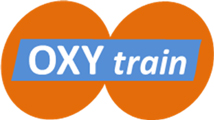Oxygenases for industrial applications
Oxygenations are of great value for organic synthesis, but often involve tedious and costly blocking and deblocking steps and are typically catalysed by heavy metals. Furthermore, they also often occur with little chemo-, regio- and enantioselectivity. Oxygenases are enzymes that catalyse the insertion of a single (monooxygenases) or both (dioxygenases) oxygen atom(s) into an organic substrate, using molecular oxygen (O2) as oxygen donor. In most cases, oxygenases utilize (in)organic cofactors, such as flavins, metal-ions and hemes, to transfer electrons to molecular oxygen for its activation.
The OXYTRAIN network will focus on cofactor-independent and flavin-, heme-, copper-dependent oxygenases which encompass an enormous range of substrate classes. In this context, the OXYTRAIN oxygenases are ideally suited for industrial applications as they are capable of catalysing highly selective oxyfunctionalisation of a wide range of organic substrates, while merely relying on molecular oxygen as a clean and cheap oxidant. Their use in industry could represent a significant reduction in both the amount of waste produced and the synthesis of undesirable by-products – the disposal of which can be expensive and inefficient. Thus, oxygenases hold a great potential for new applications in many fields, such as: textile, food, environment (biodegradation and bioremediation), biosensors, organic synthesis (chiral and asymmetric synthesis, polymers, pharmaceuticals), and biofuels. Also, current progress in biorefining of lignocellulosic biomass is to a large extent driven by the application of recently discovered monooxygenases, which have changed fundamental biochemical insights as well as drawn the attention to novel critical process parameters such as oxygen concentration and supply of reducing equivalents. As a consequence of the increasing availability of enzymes that can perform selective oxygenations, industry is showing more and more interest in oxidative biocatalysts. However, the potential of oxygenases is still far from being fulfilled. Their practical use compared with other industrial enzymes such as hydrolases, is limited by many factors, including the requirement for cofactor regeneration, and low stability and activities. Furthermore, the molecular functioning of some groups of oxygenases, especially the cofactor-independent ones, is still enigmatic, hindering hence their industrial application.
The OXYTRAIN network will overcome these barriers by mobilizing leading experts in four specific classes of oxygenases – flavin-dependent oxygenases, heme-dependent oxygenases, copper-dependent oxygenases and cofactor-independent oxygenases. This will enable the creation of inter-disciplinary research and exchange of knowledge on techniques and methods developed to study and engineer each class of oxygenases and that are common for all enzyme systems due to the oxygen reactivity (e.g. analyses of 18-oxygen incorporation, oxygen consumption studies, preparative-scale enzymatic oxidations, trapping and analysis of reaction intermediates, product analysis, computational design, engineering tools, enzymes assays, pre-steady state and steady state kinetics, etc). The network will range from highly required explorative advanced enzymology to the novel technical issues that emerge from using oxygenases in industrial biocatalysis, opening new possibilities to enhance the knowledge on enzyme mechanisms and design of novel industrially applicable oxygenation biocatalysts. In particular, it will improve the stability of enzyme variants (operational and storage stability), as well as achieve more active and/or selective variants, that can be produced at large scale. Below, we identify the main needs/drivers, challenges and opportunities related to each group of oxygenases.
